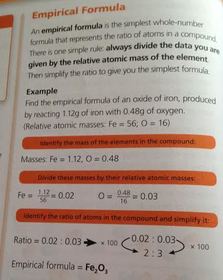Chemistry Additional (Triple) Science
Angeheftet an
119
3
0
|
|
Erstellt von HeidiCrosbie
vor etwa 10 Jahre
|
|
Schließen
|
|
Erstellt von HeidiCrosbie
vor etwa 10 Jahre
|
|

Chemistry - C2
Electronic configuration: How electrons arranged around nucleus of atom in shells. Electrons occupy lowest available shells, 1 shell 2 electrons all after can hold 8. Electronic configuration is written as a series of numbers.
Ionic compounds (Soluble in water): All carbonates of group 1 compounds e.g. K CO , Na CO . All nitrate compounds. most common chloride and sulfate compounds. All alkalis e.g. slaked lime.
If salt is formed by mixing 2 solutions is insoluble is insoluble it will form a solid precipitate. This is a precipitation reaction. Pure solid sat is formed when: Filtering, washing in filter paper & distilled water and drying in warm oven.
Test for chloride ions: Dilute nitric acid and silver nitrate solution are added to the solution of the ionic compound. If it contains chloride ions then a white precipitate will be made.
Using flames to identify ions: When held in a bunsen flame, compounds of different metals produce different flames. Sodium - Yellow, Potassium - Lilac - Calcium - Brick red, Copper - Blue green flame.
Exothermic reactions: A reaction where thermal (heat) energy is transferred out to the surroundings. This causes a rise in temperature. Combustion is an example of a exothermic reaction.
Collision theory(temperature):Low- Particles are moving slowly, collide less often, fewer collisions, reaction is less likely. High-Particles moving more quickly, collide more often with greater energy, many more collisions, more likely reactions.
Collision theory (concentration): Low - Particles spread out and collide less often, resulting in fewer successful collisions per second. High - Particles packed closely together and collide more often, resulting in more successful collisions per second.
Catalytic converters in cars: Contains a honeycomb filter where each individual cell is coated with catalysing metals. The structure increases the surface area of the converter so increases rate of conversion.
Empirical formula:

Theoretical yield: Calculated from the relative formula masses of the reactants and products.
Actual yields: The actual mass of useful product obtained from the reaction in the experiment.
Anion: A negatively charged particle formed when an atom or group of atoms lose or gain electrons.
Cation: A positively charged particle formed when an atom or group of atoms lose electrons.

 Verberge bekannte Karten
Verberge bekannte Karten